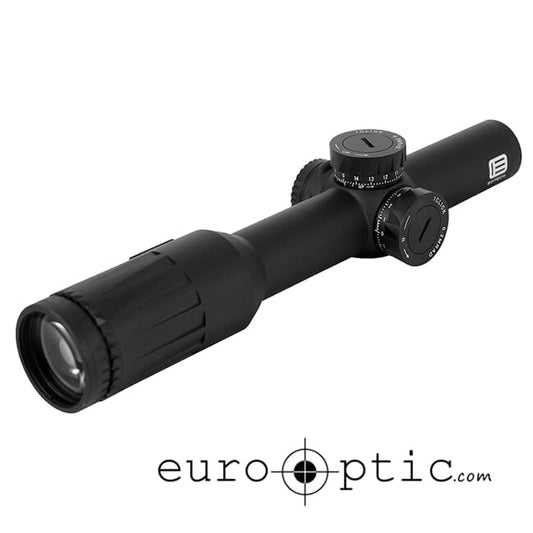

EOTech VUDU 1-6x24 FFP SR1 Riflescope offers precise targeting and versatility for various shooting scenarios. With its first focal plane design, the reticle maintains accuracy regardless of magnification level, allowing for reliable holdovers. The illuminated SR1 reticle enhances visibility in low-light conditions, making it suitable for dusk or dawn use. Built from aircraft-grade aluminum, this scope withstands tough environments and heavy recoil, ensuring durability and performance in demanding situations.
Equipped with XC™ high-density, low dispersion glass, the VUDU 1-6x24 delivers exceptional clarity and light transmission. The anti-reflective coating on the lenses minimizes glare, enhancing image quality for better target acquisition. This riflescope is nitrogen-purged and o-ring sealed, offering fog-resistance, water-resistance, and shock-resistance. Its compact design is compatible with AR platforms and bolt-action rifles, making it an ideal choice for tactical applications and competitive shooting alike.
Features – Key Benefits
- AIRCRAFT GRADE CONSTRUCTION: Built from aircraft-grade aluminum with an anodized finish for exceptional durability.
- FOG RESISTANT: Nitrogen gas purging prevents internal fogging, ensuring clear images in varying temperatures.
- SHOCK RESISTANT: Designed to withstand heavy recoil and rough handling for longevity in the field.
- WATER RESISTANT: O-ring seals keep moisture and dust out, protecting internal components.
- ANTI-REFLECTIVE COATINGS: XC™ high-density glass with anti-reflective coatings for bright, clear images.
- ILLUMINATED RETICLE: SR1 reticle provides enhanced visibility in low light, aiding quick target acquisition.
- PRECISE ADJUSTMENTS: Tool-less elevation and windage turrets for easy zeroing and tracking.
- VERSATILE MAGNIFICATION: 1-6x magnification range suitable for both close and long-range shooting.
Technical Specifications
| Specification | Details |
|---|---|
| Magnification | 1-6x |
| Focal Plane | First |
| Tube Diameter | 30 mm |
| Objective Diameter | 24 mm |
| Overall Length | 10.63 inches (270 mm) |
| Weight | 20.1 oz (570 g) |
| Eye Relief | 1X: 3.27-3.94 inches (83-100 mm), 6X: 3.23-3.94 inches (82-100 mm) |
| Field-of-View @ 100 Yards | 1X: 102.4 ft (31.2 m), 6X: 16.7 ft (5.09 m) |
| Reticle | SR1 (MRAD) |
| Illumination | Yes |
| Battery Type | CR2032 |
| Adjustment Graduation | 0.2 MRAD |
| Total Elevation Travel | 29 MRAD |
| Total Windage Travel | 23 MRAD |
| Material | Aircraft-grade aluminum |
| Finish | Anodized |
| Water Resistance | Yes |
| Fog Resistance | Yes |
| Shock Resistance | Yes |
What's in the Box?
- Vudu® 1-6X24 Rifle Scope
- Operator Manual
- Reticle Manual
- Throw Lever
- Lens Cleaning Cloth
- Battery
Customer Reviews
“This scope has exceeded my expectations for clarity and ease of use. Perfect for competitive shooting!”
“The illuminated reticle is a game-changer for low-light conditions. Highly recommend!”
“Sturdy and reliable. I’ve been using it on my AR-15 without any issues.”
FAQ
How does the first focal plane reticle work in this riflescope? The first focal plane design ensures that the reticle size changes with magnification. This allows for accurate holdover calculations at any power setting, making it ideal for both close and long-range shooting.
Is the EOTech VUDU 1-6x24 suitable for low-light conditions? Yes, the illuminated SR1 reticle provides enhanced visibility, making it effective in low-light situations. The anti-reflective coatings on the lenses also improve clarity during such conditions.
Can I use this scope in wet conditions? Absolutely. The EOTech VUDU is water-resistant due to its O-ring seals, preventing moisture from entering the scope, which ensures reliable performance in rain or snow.
How does this scope compare to other brands? The VUDU 1-6x24 offers a competitive edge with its high-density glass and durable construction. It stands out for its clarity and precision, often being a preferred choice among tactical and competitive shooters.
What maintenance is required for this riflescope? Routine cleaning of the lenses with a soft cloth will maintain optimal performance. Ensure that the scope is stored in a dry place and check the battery regularly to ensure the illumination feature works when needed.
Similar Models
Looking for more options? Explore our extensive EOTech collection, including models like EOTech VUDU 3.5-18x50 for long-range precision and EOTech VUDU 5-25x50 for advanced tactical applications. Discover our full
You May Also Like
Here’s some of our most similar products people are buying. Click to discover trending style.








